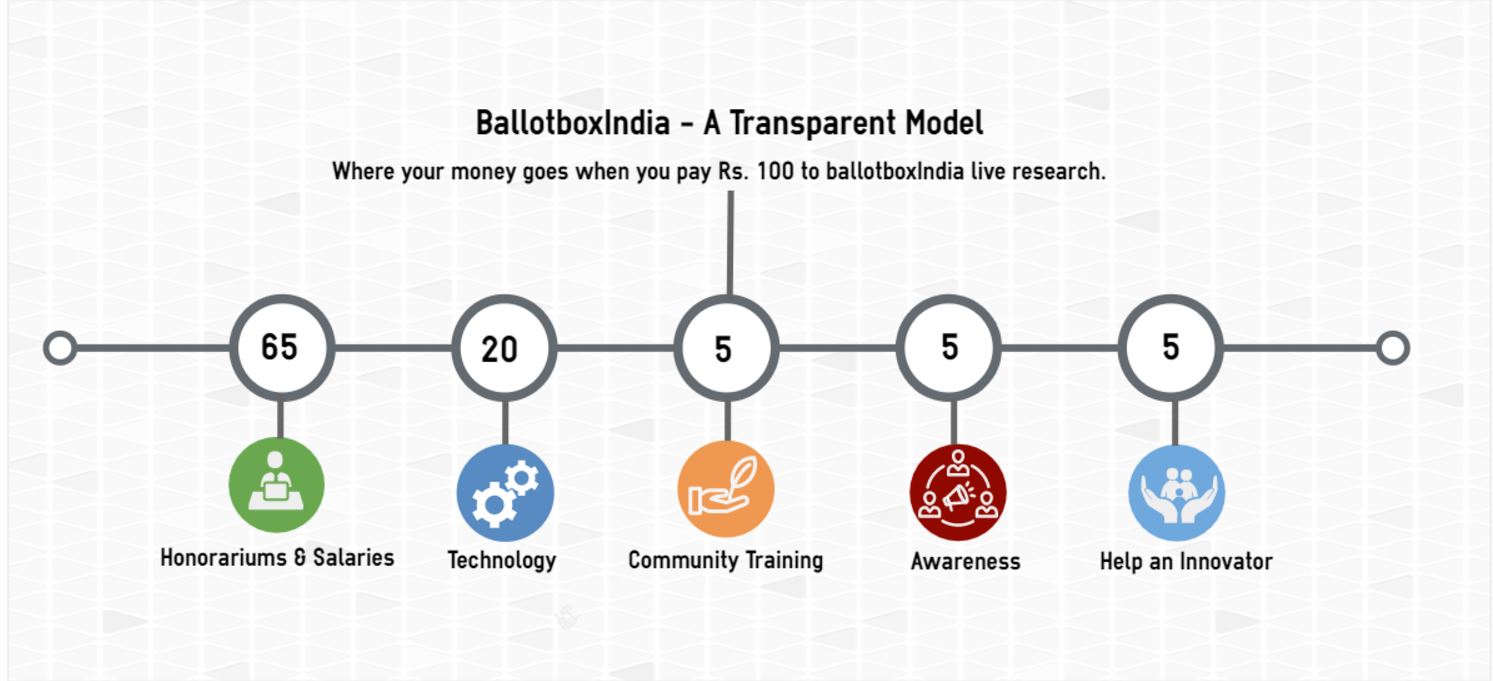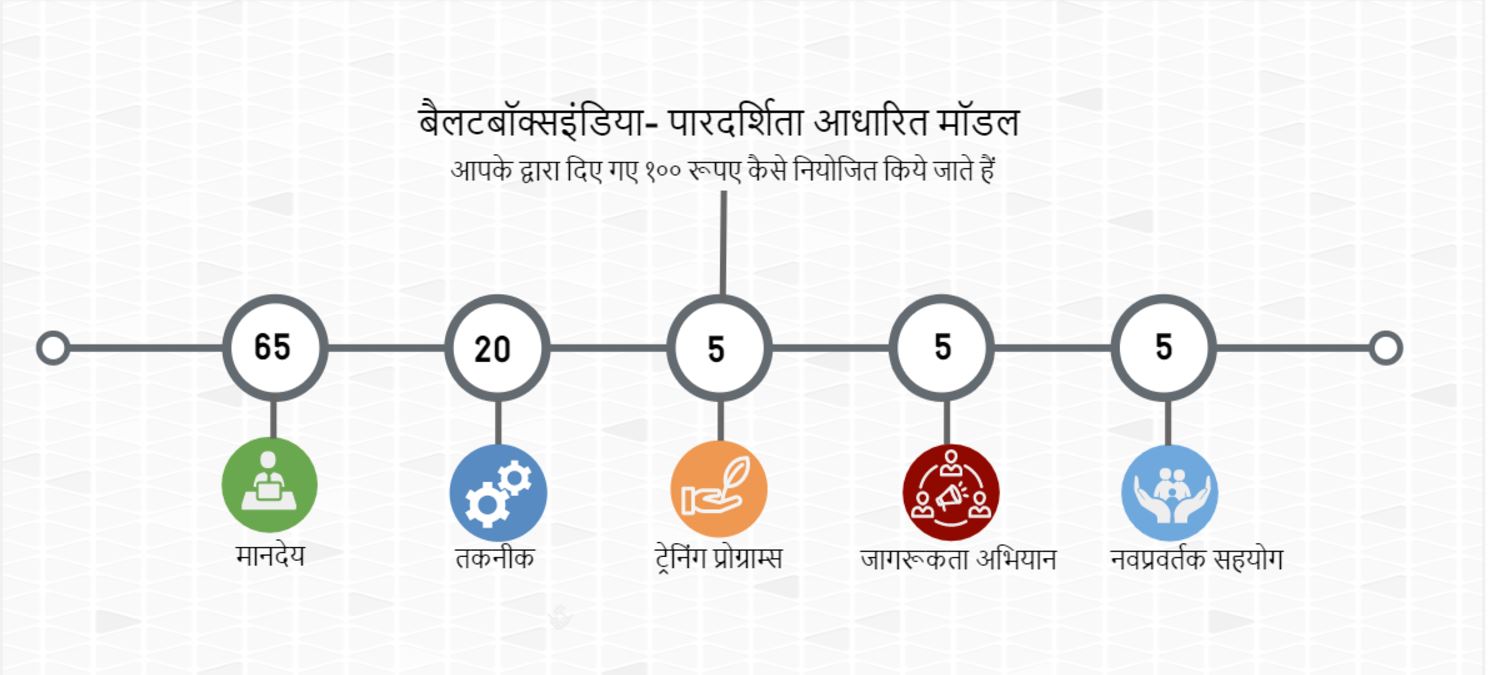These elections saw for the first time the increasing role of the media in reaching out to the voters and political parties reaching out to voters through the media.
Some say there was a ‘Ámericanization of Índian election’ with the way political leadership was being projected. With a view to understanding the role of media in the voting behavior of the electorate, this study understands the role media plays in forming public opinion and the effect media coverage can have on shaping the electoral mandate.
Secondly, this research studies to what extent voters are exposed to different media (radio, television, internet and social media).
Thirdly, the role of various factors that affect voter turnout has been studied.
Fourthly, the role of women and men voters, literate and illiterate voters is understood.
Fifthly, various factors that affected voting (horse-race coverage, candidate coverage, issue coverage, party affiliations) by the electorate is studied.
Sixthly, the kind of election coverage (agenda-setting, priming, framing, game frame) that existed in parliamentary elections 2014 is analyzed. Seventhly, the study analyses how the role of Election Commission may be improved and how the conduct of elections may be improved in future.
The study has proposed recommendations that election coverage in India should be revised by media organizations. This research moves beyond the role of ‘opinion leaders’ in a polity stressing on the significant role of technology and media in the years to come.
Keywords: Lok Sabha election, parliamentary election, Indian election, media effect, voting behavior, media influence, public opinion
Introduction
Until 1967 the state and the Lok Sabha elections were conducted simultaneously.
Today it is an exercise that involves a huge amount of energy, resources and the entire machinery of the nation to conduct them in the best possible manner.
Media coverage of elections is immense where every effort is made by media organizations to follow highest standards of journalism in the process. Media coverage of elections affects and influences people and voters in a large way.
At one time Election Commission felt that opinion polls may sway public opinion in favor of or against a party. This makes the democracy a weak one with the press getting the ultimate power to decide and discuss elections.
Some say that freedom of the press is curtailed with the ban on opinion polls. However, the nature in which elections and electoral issues are discussed undermines the role of a vibrant democracy.
The press is not above public opinion or above electorate. In the bid to show major electoral issues, the real issues get sidelined or neglected and the ones that come on center stage are the ones considered necessary by political parties or considered important by a handful of gatekeepers.
This study is inspired by claims that
Opinion polls must be banned altogether, even in between phases of voting. Media coverage of elections takes place depending upon the limited training of journalists along with politician-journalist liaison.
The real decision-makers are the people but does that genuine public opinion get reflected in the electoral outcome or does it tend to get swayed by unequal, biased media coverage of elections.
This forms the basic premise of the study. The research tries to analyze the various aspects of media coverage of the election of 2014 in a rural constituency of Uttar Pradesh.
There are a few operational definitions within this research:
Election: An election is a formal decision-making process by which a population chooses an individual to hold public office.
Opinion Poll: An opinion poll, sometimes simply referred to as a poll, is a survey of public opinion from a particular sample.
Exit Poll: An election exit poll is a poll of voters taken immediately after they have exited the polling stations.
Media: Communication channels through which news, entertainment, education, data, or promotional messages are disseminated. Media includes every broadcasting and a narrowcasting medium such as newspapers, magazines, TV, radio, billboards, direct mail,
telephone, fax, and the internet. Media is the plural of medium and can take a plural or singular verb, depending on the sense intended.
Bias: An inclination or preference that influences judgment from being balanced or even- handed.
Objectives of study
Specific objectives of the study are to understand what is the extent of media coverage and does media exposure affect voter turnout. The main objective is to find out the following details:
· The effect of election coverage on voting behavior of electorate
· Influence of election news coverage on voting behavior Some research questions to be answered are:
· RQ1: To what extent voters are exposed to different media (radio, television, the internet, and social media)?
· RQ2: Did media exposure affect voter turnout?
· RQ3: Which other factors affected voter turnout?
· RQ4: How many women as compared to men voters were influenced by media?
· RQ5: How many illiterate as compared to educated and literate men and women were influenced by media?
· RQ6: Which type of coverage in the media (horse race, candidate, and issue) prompted them to vote?
· RQ7: Which aspect of media coverage (agenda-setting, priming, framing, game frame) existed in this election coverage in 2014?
· RQ8: What was the role of the Election Commission?
· RQ9: How can the conduct and coverage of election be improved in future?
Statement of problem
The primary research question of the current study is to understand whether or not the election coverage influences voting behavior in India.
Most studies in this area either look at media and elections from a personal view point of the media or discuss the same from a negative perspective.
It is argued that the media has both positive and negative attributes which help contribute to electoral voting pattern and it is important to look at both these aspects.
Media are free to conduct opinion polls during elections. The mass media in India and its growth reflects the diversity and plurality of the country during the period of elections. However, there have been some arguments that the media by adopting opinion polls can sometimes distort fair dissemination of information by looking into motives of profit and private support specific parties.
It is argued that a number of civil society organizations around the country were worried that given the 2004 Election Commission role on using media for political promotion there has been an extensive misuse of the print and electronic media by various political parties and candidates around the world.
An examination of the above study factors indicates that election related studies have concentrated on positives of elections with almost negligible importance given to the negatives of the same. There is evidence to suggest the need to distinguish between news, views and political campaigning.
Limitations of study
The study is conducted in a single Lok Sabha constituency which is difficult to represent the entire state of Uttar Pradesh.
Uttar Pradesh is a multi-ethnic, multilingual and multi-cultural state. So a study in one part of the state cannot be replicated in another part.
This research will use the results after the general election of 2014. Similarly, voting during General elections 2014 wherein the primary data is to be collected from the electorate by using a questionnaire to find out how certain different voters and members from the electorate viewed these elections.
Sample size is 500 respondents. The study questionnaire and focus groups will be conducted in specific regions of the constituency including Kanpur rural area.
Research Design
Hypotheses
After much study of the literature, the hypothesis for this study -the null and alternate hypotheses are:
Ho= Media coverage of election does not influence voting behavior Ha=Media coverage of election influences voting behavior
In this case, the independent variable is ‘media coverage of election’ and the dependent variable is ‘voting behavior’.
The researcher seeks to find answers to the research questions with the help of a definite research methodology and specific tools and techniques.
Research methodology
For the purpose of the study, a mixed research methodology is undertaken. Survey method is adopted for a quantitative study and focus group discussions are taken up for a qualitative study.
Survey methodology studies the sampling of individual units from a population and the associated survey data collection techniques, such as questionnaire construction and methods for improving the number and accuracy of responses to surveys.
This method is best suited for this study as there was a need to collect details about the different sections of the population and analyze their responses to certain questions related to media habits and voter behavior. Interview schedules were administered as well.
Focus group is a form of qualitative research in which a group of people is asked about their perceptions, opinions, beliefs, and attitudes towards a product, service, concept, advertisement, idea, or packaging.
Questions are asked in an interactive group setting where participants are free to talk with other group members.
Such a triangulation method facilitates research and dissolves any margin of error in getting the results. Triangulation is a method where two or more methods are used to check the results.
Primary data collected through focus group discussions
Twelve focus groups were conducted with the rural representatives of each of these groups-
· Grassroots workers of Uttar Pradesh Congress Committee
· Grassroots workers of Samajwadi Party
· Grassroots workers of Communist Party of India (Marxist)(CPI-M)
· Grassroots workers of Aam Admi Party
· Members of Islamic Peace Foundation
· Members of Sri Guru Singh Sabha
· Members of Sangha Vichar Parishad
· Members of ‘Parivartan’, a Non-Governmental Organisation (N.G.O.)
· Members of Hunter Sena and Mahila Social Action Committee
· Group of illiterate adult voters
· Group of educated youth
· Group of young professional educated women
Primary data collection through survey questionnaires
Within various Vidhan Sabha constituencies, details of villages, wards and Qanoongo circles visited by the researcher for the purpose of data collection are as follows. The following Vidhan Sabha constituencies within one Lok Sabha constituency – Akbarpur was taken for study:
1. Akbarpur-Rania
2. Bithoor
3. Ghatampur
4. Kalyanpur
5. Maharajpur
Sample
Population and sample
The survey is conducted in Akbarpur Lok Sabha constituency where the total number of electors is 17, 66, 778. In each of the five Vidhan Sabha constituencies, respondents are picked based on simple random sampling.
It is an unbiased representation of a group. This involves taking a sample of 500 respondents from a population of the size of 17, 66, 778 electors.
The reason for choosing simple random sample is the simplicity of procedure in conducting the survey.
The survey questionnaire has been conducted to avoid the pitfalls in other forms of sampling in a region where it is usually difficult to reach by a good transport. The questionnaires were distributed to 100 people from each sub-group of the main constituency.
Findings, analysis, and discussion
Media exposure of voters
Few responses suggest that despite good media exposure media did not influence their voting behavior. Results show that media is used by the electorate to increase their knowledge and awareness but their voting behavior doesn’t get influenced.
Candidate knowledge is important to be able to vote. Sometimes media misleads so it negatively influences the voter who sometimes is more like the consumer.
Learning effect is at play- media helps make ‘an informed choice’. General election 2014 saw the widespread use of mediatised strategies by the parties and that helped change the voters’ minds.
The knowledge about voters and parties increases. It creates an awareness. Campaign strategies work more powerfully than mainstream media coverage. Election and voting is a weapon of an enlightened social citizen.
Media campaign strategies
Some respondents were influenced by neighbors, family, and friends. Media coverage is good and bad.
People power is paramount and media should not be used to promote and propagate personal agendas as it is done by some today. If media is not used properly people reject the candidate.
Media facilitates the campaigning being done by various parties. It is a platform to present the knowledge to the public. There is unwarranted and extended discussion of leadership, issues, and debates which need not be covered. Issues need more focus.
Some even had a cynical view towards elections. Due to excessive use of social media by parties some people did not vote. Social media is good for the party that uses it but a lot of people make friends blindly which is a bad use of the media.
Social media use is susceptible to web crimes.
Women versus men voters
Yes, there were more women in these elections. But there is a bias among a few men towards women candidates.
Illiterate voters feel that women are competent but people think twice before voting for her wondering whether women will be able to manage home and work together after getting the responsibility of an MP. This answers another research question:
RQ4: How many women as compared to men voters and candidates were influenced by media?
Women are steering ahead in every field. It is little wonder that they perform as women are the frontrunners in any political rally or march. Women are equally hard-working and nothing can stop them as even in lathi charges they are way ahead than men. They are fearless and dynamic. Feudal mindset exists towards women who were not allowed to vote in her family.
However, women MPs like Smriti Irani are changing the rules and have created a precedent that women can equally well contest elections and do a good job in politics. She used her ‘bahu image’ to contest the elections. Media can play an important role in more participation from women.
People wanted to be a part of the social change that’s going on. Voting is after all more of a social exercise than a political one.
Illiterate versus literate voters
Illiterate voters had more mature responses than literate ones. This answers another research question:
RQ5: How many illiterate as compared to educated and literate men and women were influenced by media?
Accountability of the candidate towards them made them vote. Media coverage of election influenced their voter turnout. More media coverage of election meant more voting. Media exposure definitely had a direct relationship with voter turnout.
Greater media coverage, greater was the voter turnout among them. Media campaign strategies taken up by various parties helped and personalization helps more than just campaigning with the help of mainstream media. Greater campaigning by Modi meant more competition for other parties. This leads to horse race coverage.
Type of coverage in the media
Respondents point to the fact that the election coverage was more of a horse-race coverage where the coverage was more on polls, leadership and candidate image instead of other more serious concerns.
They say that often journalists’ point of view is subjective and the electorate is forced to think about the type of coverage that suits the journalists and the journalists want the electorate to believe their subjective viewpoint on elections.
There is not enough support provided to the voters to make their own objective viewpoint because those issues are not brought up and the journalists’ version of ‘reality of elections’ is forced upon the viewer and the electorate.
Some voters tend to become cynics and due to hearing about the elections which are not a true picture are dissuaded from voting
Framing of election news in media
The framing of election news in Indian media has focussed more on agenda-setting and game- frames. Some respondents said that elections were contested on television and in the radio as though it were a competition, contest, and game.
This left several voters disillusioned and did not want to cast a vote as they felt that elections were not a serious issue but a ‘fun’ exercise. It diverted the voters towards concentrating on their daily chores rather than being a part of this political and social exercise. In the election coverage of 2014, media played up certain issues and items more than others and seemed to decide on an agenda for the public and for the politicians.
Impact of elections on voters
This election was similar to what Temin and Smith found in their study of the 2000 Ghanaian elections- that the media played a pivotal role in the election coverage, but the impact of the media at the grassroots level is minimal. Media outlets are consumed very differently across different parts of the constituency.
The media have a significant effect on a particular class of Indian- the urban elites the class that matters. In this case, however, the impact of such coverage has reached the urban voters and rural voters are still left out of this sort of media blitzkrieg.
There is no single lingua franca, there is low literacy rate, communications network are not too widespread and there are legal protections on free speech and expression.
Suggestions for improvement of the conduct of elections
Presidential debate culture of the US must be followed here unlike only mindless discussions on television. Debates on each and every topic should be done instead of personalized attacks on candidates as happening these days.
It is thus important to note that the findings have tilted towards media coverage not influencing voter behavior at large due to little media penetration and little media exposure of the electorate.
Quantitative data analysis
Quantitative data findings answer some and most of our research questions and indicate that media coverage of elections does not influence voter behavior.
Demographic profile
The demographic profile of candidates is such that majority of the respondents are from the age group of 18 to 29 years followed by those in the age bracket 30 to 49 years and least respondents who were fifty years or above.
Moreover, most of the candidates were males, with hundred respondents each from Akbarpur- Raniya, Bithoor, Ghatampur, Kalyanpur and Maharajpur Vidhan Sabha constituencies.
In different constituencies different occupations remained predominant among respondents- farmers were a majority in Akbarpur-Raniya, unemployed and housewives remained a majority in Bithoor, in Ghatampur students were a majority while in Kalyanpur those in private businesses remained in a majority and in Maharajpur again unemployed and housewives remained a majority.
Most of the residents were from rural or village areas and lesser from the cities. As far as the marital status of respondents is concerned there were a single man and women from Akbarpur-Raniya and Kalyanpur while from Bithoor, Ghatampur and Maharajpur there were more married respondents. In all the constituencies most respondents were educated up to college and above. Hence most of them were graduates.
The majority of the respondents spoke in Hindi while the rest spoke other local dialects. Majority of the respondents belonged to the upper caste especially Brahmins followed by Other
Backward Classes. The rest of the respondents were Muslims, Koeris, Kurmis, Yadavs, Jats, Scheduled Castes, and Jatavs.
As far as the use of social media is concerned, a majority of the respondents used social media for one to three hours daily where Facebook was the main social networking site used.
Voters, this explains, are exposed to the media to a large extent. This answers the first research question in detail spelling out how much of media is used by various respondents.
General awareness about Lok Sabha election 2014
Through the survey questionnaire, it is learned that majority of the people had little information about election through the media. Most of the knowledge about elections was received from television followed by the internet and then friends, family, relatives and village elders and then the radio.
The majority of the respondents had voted. Most of the respondents were motivated to vote by the urge to serve the country and build its future.
The various factors that motivated one to vote are that it is one’s right, everybody else was voting, for peace and security, so that their candidate wins and comes to power, for sops and gifts from political parties after they win, the candidate was from their community, strengthening democracy, for the development of the area, and in order to end the problems of water, electricity and road construction.
Assessment of the Lok Sabha election
The survey found out about how these Lok Sabha elections were gauged by the electorate through the coverage in the media. Questions were asked regarding the conduct of elections and whether they were the legal, free and fair election and completely lawful.
Responses were varied and interesting – majority of the respondents said that elections were transparent on being asked about the transparency of elections in various booths.
There were several reasons as to why people who voted or even those who did not vote thought elections were transparent- they said there was no fraud, then there were not more than one voter i-card holders, all voters were genuine, the media of the country was present at those booths, nobody had a complaint, everybody took part freely in these elections, elections were conducted lawfully, security was very strong and one person even said that he thought elections were transparent because his candidate won so they were fair.
Role of the Election Commission
One of the research questions was :
RQ8: What was the role of the Election Commission?
The survey conducted also gauged people’s responses to a pertinent question related to the role of the Election Commission during the election coverage.
Respondents had differing views and opinions. The majority of the respondents said that they thought the role of the Election Commission was satisfactory while some respondents said the role was very satisfactory and a few said the role was unsatisfactory.
Those who thought the role of the Election Commission during elections was very satisfactory thought it was due to security being good, there was no fraud and fake votes were eliminated, there was no problem during voting, all polling booths were there at the venue, all the voters got an opportunity to vote, all the complaints were being heard and solutions were found and other reasons.
There were reasons as to why the respondents felt the role of the Election Commission was only satisfactory and those reasons were- the security was good enough, there was less fraud and fake votes were eliminated, there was no problem during the elections, all polling booths were present, all voters got a chance to vote, all complaints were being heard and solutions were taken out, certain votes were wasted, people’s electricity problems did not end and other reasons.
Media effects of Lok Sabha election 2014
The majority of the respondents said they voted for the candidate who is currently in power.
There are several reasons and factors that motivated one to vote and those factors were- television coverage and talks with politicians on television, after reading about it in the newspapers, hearing about elections on the radio, reading about elections in the social media and on Facebook, listening to the talks on elections, experiencing the election campaigning, reading the candidate coverage, some people were motivated to vote due to billboards and pamphlets and election leaflets, others by listening to neighbours and opinion leaders around, few others by talking to relatives, and others in their colony.
Respondents were asked about how they found the political parties were represented- was a representation of parties, very satisfactory, satisfactory or unsatisfactory and a majority of them said that the representation was satisfactory, few found it very satisfactory and others unsatisfactory.
There were several reasons why they thought the representation was very satisfactory- all parties got fair representation and media gave free and fair and impartial coverage of the elections. Some who found the role satisfactory said – media was covered like a sport, was free and fair in its coverage, few parties and candidates got preference over others
and media was not very serious about the coverage of the election. Few respondents found the representation of parties rather unsatisfactory and the main reasons for that were- media covered the elections non-seriously, media deliberately discussed certain issues over others for TRPs, media gave preferential coverage to few candidates or parties over others.
In other words, there was horse-race coverage of the media and candidates and parties were not treated at par and equally by journalists.
Respondents were asked the question as to what should be the role of the media ideally during election coverage.
The answers were varied-
media should be more unbiased and all parties should get due coverage, reporters should be allowed inside the polling booths for better and more impartial coverage, reporters should be present there to prevent fraud and bribery, etc.,
Opinion polls should be banned, politicians should not all be allowed to feature very frequently in the media, political advertisements should be stopped in the media, there should be more coverage given to issues and manifestos, the methods of campaigning during elections should be made more transparent and visible in the media, presiding officers, etc. Should not be allowed to be in touch with the media in case they misuse it,
All campaigning should be stopped one week before campaigning across the country as elections are held in phases, during voting there must be a check on the campaigning that went on in the pre-voting phase.
After much analysis, it was found that media does not always give a positive coverage of elections in the media. Contemporary research emphasizes various cognitive and affective processes through which news media indirectly influence citizens’ political participation and preferences.
These processes are central in four types of media effects that have recently received considerable attention in the election context: agenda-setting, priming, framing, knowledge gain.
Della Vigna & Kaplan talked about the Fox News effect which again applies to Indian elections where media bias tends to alter voting behavior among voters.
Moreover, voting behavior theories are not completely scientific nor do they have definite stages of progression. There are failed attempts to target problems of political behaviour implicit in the voting process, there is little research planning leading to integrated theory construction, most political scientists do not cooperate with other researchers in fields of social science in order to research into political behaviour, the research is often characterized by poor techniques or the rule of thumb improperly applied and that voting behaviour researchers have sometimes a peculiar conception of the meaning of verification.
However here it served as a good standard to understand the voters’ opinions and leanings based on the survey.
It is also noticed that spiral of silence theory is at play here. The spiral of silence theory stipulates that individuals have a fear of isolation, which results from the idea that a social group or the society, in general, might isolate, neglect or exclude members due to the members’ opinions.
This fear of isolation consequently leads to remaining silent instead of voicing opinions. Media is an important factor that relates to both the dominant idea and people’s perception of the dominant idea. The assessment of one’s social environment may not always correlate with reality.
At a time when Narendra Modi’s election campaigns were being organized across the country in various states by the Bharatiya Janata Party there seemed to be a wave completely in his favor with very few opinions and voices to the contrary.
Conclusion
Media does not have a large impact on voter behavior or turn out at least in the rural areas of Kanpur. One of the reasons for this study was to find out the media habits of people which directed us towards the extent of media exposure in India. Findings have indicated that people are exposed to radio, television and the internet but in a limited way.
While a substantial number of people agreed to the use of radio, only a few watched television and a handful few were interested in reading the newspapers.
As people watched television during elections, some of them did not watch the news at all, rather continued to watch soaps and serials. This reduced their media exposure to the election news being telecast on television. In rural areas, such media exposure was less. People listened to the radio more than any other media use.
There was an interesting finding in this research that more than the mainstream media coverage which is quite expensive for a political party, media campaigns had a stronger influence on the voting behavior.
Media coverage as we have learned refers to the mainstream media coverage of elections- was used by parties to promote their agendas and reach out to the public. During the elections parties and candidates use various means to reach out to the voters and in that sense ‘note-for- vote’ has been highly criticized.
Media logic refers to the way of seeing and interpreting social affairs, in this case, the elections. Along with it, ‘political economy’ of media puts enough pressure on the media organizations that they often align their agendas with those of the parties in election fray.
Future research on a similar topic could look into other aspects of elections- campaigns, candidate coverage, usage of social media by various political leaders.
This study shows how electoral practices can be improved through the study on the scope for an improved role of the Election Commission.
The study has implications for NGOs working for electoral reforms and those who work towards better democratic practices. The study also is useful for media organizations to understand how media coverage can be improved.
The study works on political parties on how can campaigning and their practices be made effective for the electorate. It is useful for psephologists, political activists, and academicians who can read and learn from this and form their opinions about how elections can be studied in a rural area with a diverse population and with limited media reach and exposure.
 tag on profile.
tag on profile.




